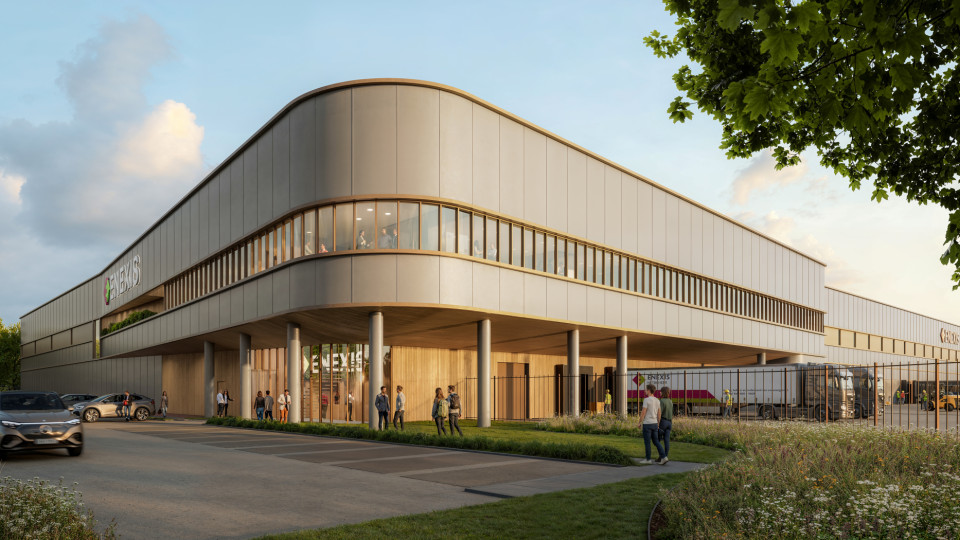How does one design a building that makes its 900 occupants feel connected? That was the challenging question posed by the design brief presented to us by Fluor, one of the world's leading engineering firms. Our response resulted in a building that corresponds perfectly with the company’s unique working methods. Our goal, in providing this response, was to create a building whose every feature would facilitate collaboration, interaction and knowledge sharing, while also allowing lots of scope for people to work separately and securely on confidential projects.
A unique combination of privacy and interaction
Fluor’s approach to its work is unlike any other in the Netherlands. Projects begin in small teams, which grow in size as the work assumes greater technical complexity and demands increasing collaborative effort, which in the end can result in teams of dozens. To facilitate this, we designed the building to allow the various teams to remain connected while keeping the sensitive information involved in their work secure. This was achieved with a combination of communal areas and separate departments, and, equally important, by creating an office building that promoted ease, comfort and productivity.
Solid yet light
On entry, staff are greeted by the liberating expanse of a huge atrium. This and the wide, wooden centrally positioned staircase allow direct visual communication with everyone and every space in the building. The black steel floor lends the atrium a weighty and authoritative air, while the vast glass roof admits an abundance of light and lends the space an air of weightlessness, the combination of which facilitates starting the workday in a positive frame of mind.
We wanted every office to enjoy an abundance of natural light without workers having to keep the blinds drawn against the glare of direct sunlight, which we also wanted to avoid on account of its potential overheating effect. To achieve this careful balance, we designed the façades to filter sunlight. Thus the hundreds of workers that populate the various floors can go about their work together with the benefits of natural light and uninterrupted views across the building.
Energy consumption halved
This is a large building, yet smart ideas like the sunlight-filtering facades have made it sustainable. The abundance of natural light in every room has kept the need for artificial lighting to a minimum. Our choices regarding insulation played an equally important role in minimising the building’s energy requirements, since much less of it is needed to keep the building cool in the summer and warm in the winter.
In addition, surplus summertime heat is stored underground and used to provide whatever supplementary heat is needed in winter; the reverse occurs when additional cool air is needed in summer. The combined effect of these and other considerations is a building with just half the energy needs of anything comparable, a notable achievement and benefit given Fluor’s decades-long tenancy intentions. Finally, the building itself generates what energy it needs, via its 2,250 m2 of photovoltaic panels. The sum effect of these measures earned the building a BREEAM Excellent certificate of environmental performance.
Project details
Gegevens
| Total floor area | 20,000 m² with car park |
| Project | Company headquarters |
| Start of design | January 2012 |
| Start of construction | August 2013 |
| Project completion | January 2015 |
| Location | Taurusavenue, Hoofddorp |
Ontwerpteam
| Client | Dura Vermeer |
| Tenant | Fluor |
| Project architects | Paul de Ruiter & Noud Paes |
| Project team | Jan Lebbink, Marlous Vriethoff, Lionel Nascimento Gomes, Caro van Dijk, Marieke Sijm, Giorgio Carella |
| Construction consultants | Corsmit Raadgevende Ingenieurs, Rotterdam |
| Building services engineering | DWA, Bodegraven |
| Structural engineering | DWA, Bodegraven |
| Sustainability advisers/BREEAM | DWA, Bodegraven |
| Interior architect | D+Z Architects + Project Managers |
| Landscape design | Lodewijk Baljon |
| Urban design | Rijnboutt |
| Construction management | Dura Vermeer |
| Costs consultants | Dura Vermeer |
| Photography | Ronald Tilleman |









